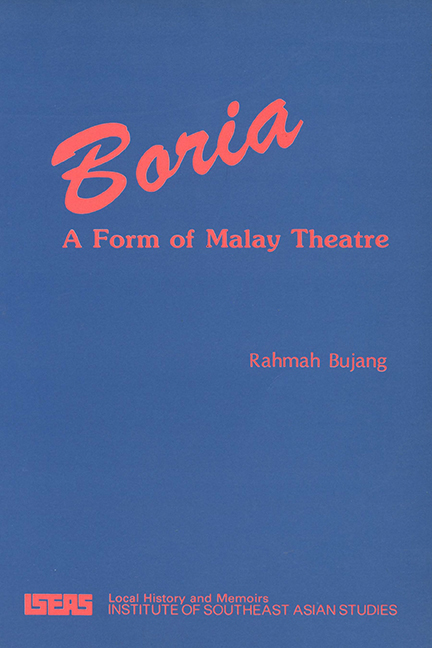3 - The Stories in the Sketches
Published online by Cambridge University Press: 21 October 2015
Summary
This chapter gives some details on ten popular stories from boria sketches. They illustrate the shows considered suitable for various occasions and for the range of stories employed. Essentially they are foundation plots used by many troupes; within the basic framework each troupe will vary the story to suit the particular audience and to bring out the skill of its performers. The dialogue is extempore. It is for these reasons that generalized stories are presented; transcribing and translating entire stories apart from increasing the bulk of the text, would tend to conceal the features common without giving the reader any clearer idea of the content of the sketches. I have also noted some of the audience reaction beyond the normal amusement encouraged by the actors in certain roles.
Examples of Stories
A. Kisah Kenduri Kahuwin [Wedding story]
The scene opens with a middle-aged couple discussing the impending marriage of their daughter. The focus of the argument is on the type of wedding they are going to have. The bride's mother wants a big wedding. She argues that her daughter will be feted but once in her lifetime, and that is on her first wedding. As a mother she does not want to suffer the shame of a small wedding feast. She must be better than her neighbours, and if they can have big wedding feasts for their daughters, she must have a better one for hers. The father is all for a small kenduri selamat (thanksgiving) in view of the fact that a big ceremony is beyond their means and would involve going into debt.
This disagreement leads them into repartee. This word battle is the important comic element in the sketch at one level, complemented by their clothes, countenance and gestures at another. The type of argument most popular with both actors and audience alike seems to run in a thrust and parry dialogue, as demonstrated in the example below:
Wife: But she is our only child! Her “catch” is a clerk who works in an office …[pauses in happy contemplation]… I want to show him off to my neighbours.[…]
- Type
- Chapter
- Information
- BoriaA Form of Malay Theatre, pp. 24 - 47Publisher: ISEAS–Yusof Ishak InstitutePrint publication year: 1987



